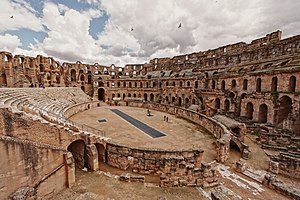El Djem
|
El Djem الجمّ Thysdrus |
|
|---|---|

The amphitheatre
|
|
| Location in Tunisia | |
| Coordinates: 35°18′N 10°43′E / 35.300°N 10.717°E | |
| Country |
|
| Governorate | Mahdia Governorate |
| Population (2014) | |
| • Total | 48,611 |
| Time zone | CET (UTC1) |
El Djem (Tunisian Arabic: الجمّ ![]() il jām; Latin Thysdrus) is a town in Mahdia Governorate, Tunisia, population 48,611 (2014 census). It is home to some of the most impressive Roman remains in Africa, like the world-famous "Roman amphitheater of Thysdrus".
il jām; Latin Thysdrus) is a town in Mahdia Governorate, Tunisia, population 48,611 (2014 census). It is home to some of the most impressive Roman remains in Africa, like the world-famous "Roman amphitheater of Thysdrus".
The Roman city of Thysdrus was built, like almost all Roman settlements in ancient Tunisia, on former Punic settlements. In a less arid climate than today's, Thysdrus, which became part of the Roman province of Byzacena, prospered especially in the 2nd century, when it became an important center of olive oil manufacturing for export. It was the seat of a Christian bishopric, which is included in the Catholic Church's list of titular sees.
By the early 3rd century AD, when the amphitheater was built, Thysdrus rivaled Hadrumetum (modern Sousse) as the second city of Roman North Africa, after Carthage. However, following the abortive revolt that began there in 238 AD, and Gordian I's suicide in his villa near Carthage, Roman troops loyal to the Emperor Maximinus Thrax destroyed the city.
...
Wikipedia

